Fender Jaguar Rosewood Prototype Solid Body Electric Guitar (1968)
This item has been sold.
Item # 12492
Prices subject to change without notice.
Fender Jaguar Rosewood Prototype Model Solid Body Electric Guitar (1968), made in Fullerton, California, serial # 216732, natural finish, Brazilian rosewood body, maple neck with maple fingerboard, original black tolex hard shell case.
This is one of the flat-out coolest and absolutely rarest CBS-era Fenders we have ever seen: a 1968 Jaguar built on a solid Brazilian rosewood body with a first-issue maple fingerboard neck with black block inlay and binding. While the 1968-9 rosewood Telecaster became iconic (and a short-lived production item) there is no record of any other Jaguar (or Jazzmaster) existing in this configuration. Rosewood Telecaster and Stratocaster prototypes followed later in 1968, but today in a time when offset body Fenders are experiencing their greatest popularity in 60 years this is a truly amazing find.
The post-Leo design team at CBS/Fender were often casting around for new ideas; after all they had to justify their existence to the corporate management team! The 1966-69 era is rife with oddball and one-off Fenders, most of which never went into production. Roger Rossmeisel, who had designed the acoustic flat top line for Leo and the Coronados for CBS was the main ideas man assisted by a young Phil Kubicki, who had worked at Fender since 1964. Babe Simioni in assembly sometimes had input as well. This guitar has their fingerprints on it, and likely served as the initial test of concept for all rosewood-bodied instruments that followed.
Think about it; in 1967-68 if Fender is going to offer a new deluxe fancy wood model what was the prestige guitar? Not the humble Telecaster, although that 15+ year old design was then experiencing renewed popularity. The Stratocaster? Well, that was also an "outdated" model, and the influence of Jimi Hendrix in reviving it had not really kicked in yet. The top of the Fender line was the flashy Jaguar, although the model's sales were falling into decline in the "Heavy" music age that would not have yet been fully evident in early 1968. The Jaguar was the top-of-the-line, thus this super deluxe rosewood prototype was the first of its kind.
The body is made of two solid blocks of beautifully grained Brazilian rosewood, laminated with a thin maple center strip like the subsequent rosewood Telecasters produced between later. It is finished in a natural Poly, highlighting the grain, a new idea at Fender in 1968. The maple neck has a laid-on maple fingerboard with black blocks and binding, a custom-order option recently introduced for higher-end Fenders including the Jaguar, Jazzmaster and Jazz Bass. The heel is stamped 15 MAR 68 B; there is a script pencil marking on the underside of the heel under the finish that appears to say "Pale JAG" with an "E" die stamp adjacent. The early spring neck stamp its typical of instruments intended for the summer trade show, giving sufficient lead time for special builds.
The pickguard its the white plastic style typically used on post-1964 custom-color Jaguars; the hardware and electronics are standard fittings for the model. The pots are coded the 304 6547 and 304 6617 as is typical for '68 Fenders, as much of the huge order CBS made in early '66 was still in stock. The finish is the first-generation Polyester Fender had recently begun using, thicker than the older Nitro lacquer but not nearly as heavy as the 1970s "Thick Skin" to come. This prototype Jaguar weighs in at 11.39 lbs. showing one of the disadvantages to solid rosewood construction. The wood is also somewhat difficult to work, hard on tooling and also problematic for Fender to finish effectively. Carving the sculpted Jaguar body was likely challenging, and the result was likely not received well enough by Fender dealers to merit pursuing.
This guitar's history is obscure; it was likely shown at NAMM 1968, used as a sample for the Rosewood guitar concept. It apparently then disappeared but shows wear indicating it served as a gigging guitar. Based on the serial number and neck markings it pre-dates (by several months at least) the hand-made Rosewood Telecasters and Stratocasters Rossmeisel and Kubicki assembled later in 1968, which additionally had solid rosewood necks. Fender sales planned to give these samples to Elvis Presley, George Harrison and Jimi Hendrix. Elvis apparently tried and returned his; Hendrix never got one but Harrison did, using the rosewood Telecaster during the 1969 filming of "Let It Be" especially for the Beatles' final rooftop performance. As a result that model eventually went into (fairly brief) production.
Like this guitar those had a solid rosewood body with a very thin "sandwich" layer of maple in the center; subsequent production rosewood Telecasters were partially hollowed out to alleviate the weight. This guitar is absolutely unique; it is the ONLY offset Fender known to have been made in this rosewood-body format and was apparently lost and forgotten for decades. It resurfaced about 15 years ago, showing signs of serious use but still a fantastic sounding unicorn housed in its original Fender black hardshell case.
Overall length is 40 in. (101.6 cm.), 14 in. (35.6 cm.) wide at lower bout, and 2 in. (5.1 cm.) in depth, measured at side of rim. Scale length is 24 in. (610 mm.). Width of nut is 1 5/8 in. (41 mm.)., 11.39 lbs.
This is a unique one-of a kind guitar; while it shows wear it is generally well preserved and remains nearly all original, with some minor restoration. The body finish shows evidence of the difficulty Fender had finishing rosewood to resist wear. There is lateral checking overall, a number of dings and chips and an area of noticeable flaking at the bass side lower bout from arm contact, with additional spots worn off by the strap buttons and along the back edge. There is play wear down to the wood on the back of the neck and along the treble side up to about the 5th fret area. The fingerboard was refretted with slightly larger wire and sprayed over some time ago.
The hardware on the guitar presents as all original; at one time the headstock was apparently fitted with Schaller tuning keys but restoration of original Fender "F" tuners is so well done as to make that practically invisible. All other components are original and correct, both inside and out; the solder joint on the back of the tone pot may have been re-done but the wiring remains unaltered.
The mute system is disabled but intact; it could be set up to operate if desired. The tremolo arm is original; the snap-on bridge cover long gone. There is some general plating wear, particularly to the trem baseplate and bridge saddles. One screw head on the bridgeplate/tremolo assembly has been broken off and glued in place foe appearance sake.
This guitar has its own sound, more powerful than many Jaguars with a definite edge. It plays very well and although obviously heavier than average presents beautifully and has a character that can't be beat. For the offset Fender collector or connoisseur this is a truly amazing find, a limitedly unique opportunity far rarer than any Custom Color guitar and a fantastic, previously undocumented but important piece of fender history. It comes in the original orange-lined Fender hard case, worn but solid. We wish the guitar could tell us where it was from 1968-2008, but perhaps the answer will emerge someday! Overall Very Good + Condition.
This is one of the flat-out coolest and absolutely rarest CBS-era Fenders we have ever seen: a 1968 Jaguar built on a solid Brazilian rosewood body with a first-issue maple fingerboard neck with black block inlay and binding. While the 1968-9 rosewood Telecaster became iconic (and a short-lived production item) there is no record of any other Jaguar (or Jazzmaster) existing in this configuration. Rosewood Telecaster and Stratocaster prototypes followed later in 1968, but today in a time when offset body Fenders are experiencing their greatest popularity in 60 years this is a truly amazing find.
The post-Leo design team at CBS/Fender were often casting around for new ideas; after all they had to justify their existence to the corporate management team! The 1966-69 era is rife with oddball and one-off Fenders, most of which never went into production. Roger Rossmeisel, who had designed the acoustic flat top line for Leo and the Coronados for CBS was the main ideas man assisted by a young Phil Kubicki, who had worked at Fender since 1964. Babe Simioni in assembly sometimes had input as well. This guitar has their fingerprints on it, and likely served as the initial test of concept for all rosewood-bodied instruments that followed.
Think about it; in 1967-68 if Fender is going to offer a new deluxe fancy wood model what was the prestige guitar? Not the humble Telecaster, although that 15+ year old design was then experiencing renewed popularity. The Stratocaster? Well, that was also an "outdated" model, and the influence of Jimi Hendrix in reviving it had not really kicked in yet. The top of the Fender line was the flashy Jaguar, although the model's sales were falling into decline in the "Heavy" music age that would not have yet been fully evident in early 1968. The Jaguar was the top-of-the-line, thus this super deluxe rosewood prototype was the first of its kind.
The body is made of two solid blocks of beautifully grained Brazilian rosewood, laminated with a thin maple center strip like the subsequent rosewood Telecasters produced between later. It is finished in a natural Poly, highlighting the grain, a new idea at Fender in 1968. The maple neck has a laid-on maple fingerboard with black blocks and binding, a custom-order option recently introduced for higher-end Fenders including the Jaguar, Jazzmaster and Jazz Bass. The heel is stamped 15 MAR 68 B; there is a script pencil marking on the underside of the heel under the finish that appears to say "Pale JAG" with an "E" die stamp adjacent. The early spring neck stamp its typical of instruments intended for the summer trade show, giving sufficient lead time for special builds.
The pickguard its the white plastic style typically used on post-1964 custom-color Jaguars; the hardware and electronics are standard fittings for the model. The pots are coded the 304 6547 and 304 6617 as is typical for '68 Fenders, as much of the huge order CBS made in early '66 was still in stock. The finish is the first-generation Polyester Fender had recently begun using, thicker than the older Nitro lacquer but not nearly as heavy as the 1970s "Thick Skin" to come. This prototype Jaguar weighs in at 11.39 lbs. showing one of the disadvantages to solid rosewood construction. The wood is also somewhat difficult to work, hard on tooling and also problematic for Fender to finish effectively. Carving the sculpted Jaguar body was likely challenging, and the result was likely not received well enough by Fender dealers to merit pursuing.
This guitar's history is obscure; it was likely shown at NAMM 1968, used as a sample for the Rosewood guitar concept. It apparently then disappeared but shows wear indicating it served as a gigging guitar. Based on the serial number and neck markings it pre-dates (by several months at least) the hand-made Rosewood Telecasters and Stratocasters Rossmeisel and Kubicki assembled later in 1968, which additionally had solid rosewood necks. Fender sales planned to give these samples to Elvis Presley, George Harrison and Jimi Hendrix. Elvis apparently tried and returned his; Hendrix never got one but Harrison did, using the rosewood Telecaster during the 1969 filming of "Let It Be" especially for the Beatles' final rooftop performance. As a result that model eventually went into (fairly brief) production.
Like this guitar those had a solid rosewood body with a very thin "sandwich" layer of maple in the center; subsequent production rosewood Telecasters were partially hollowed out to alleviate the weight. This guitar is absolutely unique; it is the ONLY offset Fender known to have been made in this rosewood-body format and was apparently lost and forgotten for decades. It resurfaced about 15 years ago, showing signs of serious use but still a fantastic sounding unicorn housed in its original Fender black hardshell case.
Overall length is 40 in. (101.6 cm.), 14 in. (35.6 cm.) wide at lower bout, and 2 in. (5.1 cm.) in depth, measured at side of rim. Scale length is 24 in. (610 mm.). Width of nut is 1 5/8 in. (41 mm.)., 11.39 lbs.
This is a unique one-of a kind guitar; while it shows wear it is generally well preserved and remains nearly all original, with some minor restoration. The body finish shows evidence of the difficulty Fender had finishing rosewood to resist wear. There is lateral checking overall, a number of dings and chips and an area of noticeable flaking at the bass side lower bout from arm contact, with additional spots worn off by the strap buttons and along the back edge. There is play wear down to the wood on the back of the neck and along the treble side up to about the 5th fret area. The fingerboard was refretted with slightly larger wire and sprayed over some time ago.
The hardware on the guitar presents as all original; at one time the headstock was apparently fitted with Schaller tuning keys but restoration of original Fender "F" tuners is so well done as to make that practically invisible. All other components are original and correct, both inside and out; the solder joint on the back of the tone pot may have been re-done but the wiring remains unaltered.
The mute system is disabled but intact; it could be set up to operate if desired. The tremolo arm is original; the snap-on bridge cover long gone. There is some general plating wear, particularly to the trem baseplate and bridge saddles. One screw head on the bridgeplate/tremolo assembly has been broken off and glued in place foe appearance sake.
This guitar has its own sound, more powerful than many Jaguars with a definite edge. It plays very well and although obviously heavier than average presents beautifully and has a character that can't be beat. For the offset Fender collector or connoisseur this is a truly amazing find, a limitedly unique opportunity far rarer than any Custom Color guitar and a fantastic, previously undocumented but important piece of fender history. It comes in the original orange-lined Fender hard case, worn but solid. We wish the guitar could tell us where it was from 1968-2008, but perhaps the answer will emerge someday! Overall Very Good + Condition.












